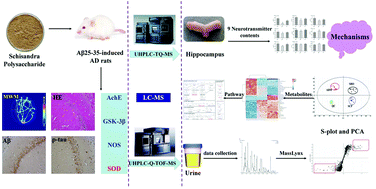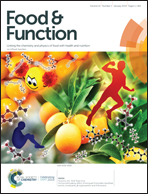Pharmacodynamic and urinary metabolomics studies on the mechanism of Schisandra polysaccharide in the treatment of Alzheimer's disease†
Abstract
Schisandra chinensis (Turcz.) Baill is produced mainly in northeast China, Korea and Japan. Its fruit has been used in food as a nutritional and functional ingredient for centuries. Polysaccharide is an important chemical component in Schisandra. Previous studies have shown that Schisandra polysaccharide (SCP) could be used to improve cognitive function clinically and treat age-related neurodegenerative disorders. In this study, a urinary metabolomics method based on ultra-high-performance liquid chromatography combined with quadrupole-time-of-flight mass spectrometry (UHPLC-Q-TOF-MS) was established to investigate the change of endogenous metabolites in an amyloid β-protein (Aβ) 25–35-induced Alzheimer's disease (AD) rat model. Meanwhile, levels of 9 neurotransmitters were evaluated with ultrahigh-performance liquid chromatography-triple-quadrupole mass spectrometry (UHPLC-TQ-MS) to explore the therapeutic mechanisms of SCP on the AD rat model. Additionally, the synthesis of phosphorylated tau protein (p-tau), acetylcholinesterase (AchE) activity and oxidative damage in the brain of the AD rats were assessed using glycogen synthase kinase-3β (GSK3β), AchE and antioxidant assays, NOS (nitric oxide synthase) and SOD (superoxide dismutase), respectively. The results indicated that the AD model was established successfully and the inducement of Aβ25–35 caused the phosphorylation of tau protein and the deposition of Aβ. In the AD model rats, the levels of AchE, GSK-3β and NOS were significantly elevated and SOD activity was reduced. In the hippocampus of the model rats, the contents of γ-aminobutyric acid, acetylcholine, glycine, norepinephrine, taurine, serotonin and dopamine were significantly decreased and the contents of glutamate and aspartic acid were increased significantly. However, SCP could reduce the degree of phosphorylation of tau protein, the deposition of Aβ and oxidative damage and reverse these changes of neurotransmitters in the AD rats. In a metabolomics study, a total of 38 metabolites were finally identified as potential biomarkers of AD and all of them had a significant recovery compared with the AD model after SCP administration. Metabolomics studies have shown that SCP plays a role in protecting the central nervous system, regulating intestinal microbial metabolism, regulating energy metabolism, and promoting antioxidant effects by regulating the levels of endogenous metabolites in related pathways. This is first report of the use of urine metabolomics combined with the evaluation of 9 neurotransmitter levels to investigate the mechanism of SCP on the treatment of AD.



 Please wait while we load your content...
Please wait while we load your content...